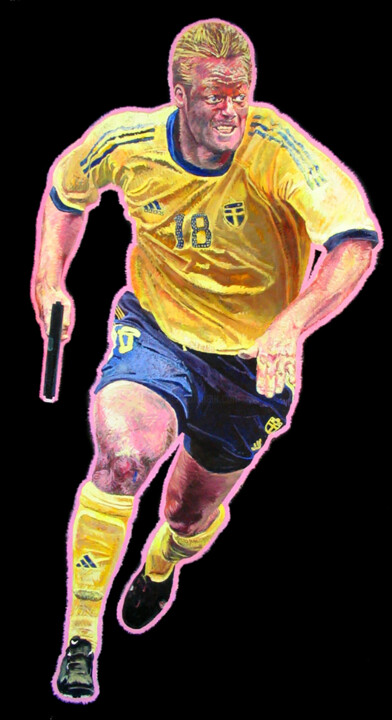




让我们知道您是否想看到这件艺术品的更多照片!
- 工作的背面 / 工作的一面
- 细节 / 签名 / 艺术品的表面或纹理
- 情境中的艺术品, 其他...
Act On Instinct (2004) 绘画 由 Anton Terziev
更多信息
- 包装 (盒子或纸箱包装) 所有的作品都配有优质的承运方,经过严格的包装保护和已投保。
- 监控 跟踪订单,直到包裹交付给买方. 将提供跟踪号码,以便您可以实时跟踪包裹。
- 延迟 全球配送会在3-7天内送达 (估计)
- 不包括海关 价格不包括海关费用。大多数国家/地区对原创艺术品没有进口税,但您可能需要支付减免的增值税。海关费用(如果有)将由海关在抵达时计算,并由承运人单独计费。
更多信息
- 可追踪的在线真品证书 可以通过扫描插图的代码随时在线验证真品证书。
- 认证评级艺术家 专家研究一个艺术家的工作和职业生涯,然后建立一个独立的,可靠的平均价格值。平均价格价值座落在一个价格范围内的某一时期的艺术家。专家们也可能被要求建立一个更精确的估计为特定的工作。
更多信息
使用SSL证书进行100%安全付款 + 3D Secure.
更多信息
“艺术”在纸上打印
这是使用非常高质量的颜料墨水在美术纸上打印并以很高的清晰度打印的过程。它的保存水平非常出色(超过100年),其质量,深度和细微差别超过了在Argentic纸上的经典照片打印。

光面漆
纤维纸除了具有非凡的厚度外,还由不含酸的α-纤维素基底组成,并覆盖有硫酸钡和在印刷过程中具有微孔层吸收作用的颜料。这款纸色为纯白色,不泛黄,特别设计用于抵抗老化。它具有出色的分辨率,呈现深沉的色彩,因此已被世界各大博物馆所采用。
Art Print“美术”-在325 g纤维原纸上的光泽处理。

我们的高端印刷品和复制品
ArtMajeur仅使用从知名造纸商中精选的具有中性pH,耐性和高质量的天然纸!
无论是在色彩控制还是在图形链方面,我们的主打印机一直都在关注。我们对质量的高要求是ArtMajeur裱框艺术品的主要资产。
关于艺术家! 您可以帮助艺术家活出自己的生活。 每当您购买印刷品时,他们都会获得使用费。
关于我们的优良打印购买许可证以将此图像用于您的网站、通信或销售衍生产品。
Usage: 网络许可证
| 817 px | ||

|
1500 px |
| 文件尺寸 (px) | 817x1500 |
| 全球使用 | 是 |
| 用于多点支持 | 是 |
| 用于任何类型的媒体 | 是 |
| 转售权 | 没有 |
| 最大打印数量 | 0 (Zero) |
| 拟出售的产品 | 没有 |
购买后立即下载
此图片可以用许可证下载: 您可以随时下载它们。
限制
所有在ArtMajeur的图像是由艺术家创作的原创作品,所有权利是严格保留的。获得许可证后有权根据相应条款使用或利用图像。可以进行微小的修改,如重构或重新聚焦图像,使其完全符合新项目要求,但是,禁止进行任何可能损害原始作品的修改。其完整性(形状修改,扭曲,切割,改变颜色,添加元素等),除非事先从艺术家获得书面授权。
定制许可证
如果您的用途不在我们的标准许可证范围内,请联系我们获取定制许可证。
艺术图片银行-
原创艺术品 (One Of A Kind)
绘画,
油
在帆布上
- 外形尺寸 高度 70.9in, 宽度 43.3in
- 艺术品状况 艺术品完好无损
- 是否含画框 此作品未装裱
- 分类 画作 低于US$5,000 表现主义 政治
At first glance, the painting is dominated by the muscular form of the football player, captured in motion. His determined expression, tense posture, and forward propulsion suggest an athlete at the height of competitive focus. The striking juxtaposition, however, comes from the pistol gripped in his right hand—a deliberate disruption of the typical imagery associated with football. The black background intensifies this visual shock, placing the spotlight on the player’s dynamic pose and the incongruity of his weapon.
In art-historical terms, the composition recalls the tradition of the single-figure portrait, reminiscent of classical heroic representations where warriors or saints stride forward against a neutral field. Here, Terziev cleverly replaces the classical sword or spear with a modern firearm, casting the sportsman in a role more akin to a soldier than a player.
The Swedish national jersey’s bold yellow hue signifies energy, optimism, and national pride. Contrasted with the gunmetal black of the firearm and the pitch-black background, this bright color palette underscores the unsettling tension in the piece. Historically, yellow can symbolize enlightenment or hope, yet Terziev’s context repositions it as a backdrop to impending violence or threat.
The pink outline that envelops the figure heightens the painting’s Pop-Art sensibility, giving the player a neon aura that both separates him from the darkness and hints at the artificial glamour sometimes associated with professional sports and celebrity culture. This color choice also resonates with the shock and immediacy of street art, reinforcing the painting’s capacity to grab the viewer’s attention and spark reflection on deeper themes.
The title *Act on Instinct* is central to understanding the painting’s narrative. Sports, especially football, are often portrayed as controlled outlets for aggression—arenas where players channel energy and skill into a socially sanctioned competition. The introduction of a gun into this otherwise familiar athletic scene suggests a collapse of that controlled environment. It hints at the possibility that the “instinct” at play is not merely the competitive drive but also a more primal, violent reflex.
In a broader cultural sense, Terziev may be critiquing how society conflates sportsmanship with militaristic or combative language: we talk about “battles on the pitch,” “attacking formations,” and “defensive lines.” By placing a literal weapon in the athlete’s hand, Terziev visualizes the latent aggression lurking beneath the surface of organized sports. The painting also speaks to global anxieties over the ways violence seeps into entertainment, fan culture, and even nationalism.
Terziev’s blend of realism and stylization is evident in the confident brushstrokes and attention to the player’s physique—muscles, sweat, and facial tension are rendered with a painterly realism that emphasizes effort and urgency. Yet, the pink outline around the figure breaks from traditional realism, recalling graphic or pop art influences. This approach amplifies the painting’s immediacy, transforming the athlete into a larger-than-life emblem rather than a mere portrait.
The medium of oil paint, with its capacity for rich color saturation and subtle texture, allows Terziev to balance the tension between hyper-focused detail (the folds in the jersey, the reflection on the gun) and bold, flattened outlines. The resulting aesthetic underscores the painting’s thematic contradiction: a deeply tangible human figure holding an almost iconically rendered weapon.
Viewed in the context of modern sports culture, *Act on Instinct* resonates with concerns about the commodification of athletic events, the glorification of violence, and the uneasy overlap of patriotism and aggression. Football, hailed as the world’s game, has often been a vessel for national identity and unity, but it has also seen episodes of fan violence, political manipulation, and media sensationalism. Terziev’s painting may be read as a metaphor for these tensions: the player’s gun disrupts the celebratory image of the national hero, reminding viewers of the darker impulses that can lurk within collective sports fervor.
The work also speaks to broader dialogues in contemporary art, where the merging of popular iconography with jarring, often violent elements challenges the viewer to reassess cultural values. In line with postmodern critiques of mass media, Terziev’s insertion of a gun—traditionally a symbol of threat—into the realm of sport, a domain typically linked with camaraderie or national pride, forces an interrogation of how violence and competition intersect in public consciousness.
Anton Terziev’s *Act on Instinct* confronts its audience with a vivid and unsettling image of a gun-wielding football player. The painting’s dynamic composition, bold color palette, and pop-art outline converge to create a piece that is at once visually arresting and deeply layered in meaning. By uniting the domains of sport and armed conflict, Terziev provokes a reevaluation of the instincts that drive both competitive excellence and destructive aggression.
In doing so, the painting aligns itself with a lineage of art that uses shock and juxtaposition to question the status quo. *Act on Instinct* stands as a testament to Terziev’s ability to fuse technical skill with conceptual bite, compelling viewers to reflect on the sometimes razor-thin line between sport and violence, pride and hostility, spectacle and threat.
after Mattias Jonson's photography image
相关主题
安东·泰尔齐耶夫 (Anton Terziev) 是一位当代保加利亚艺术家,他是一位运用尖锐讽刺作为艺术工具来处理各种当代主题的大师。他的作品的特点是对图像的深刻运用,传达了鲜明而批判性的意象。在他的艺术作品中,安东巧妙地将赌注、技巧和讲故事的元素编织在一起,产生了具象的当代艺术,其中带有社会评论、幽默和关于艺术家状况的信息。
安东·泰尔齐耶夫 (Anton Terziev) 从两个不同的来源汲取灵感。首先,他的艺术往往源于现实生活中的事件,以激发他的创作过程的方式在他周围展开。其次,他的想象力在他的作品中发挥着关键作用,使他能够创作出生动且发人深省的图像。他的每件作品都装饰着从电影和书籍中提取的流行文化的微妙元素。每件作品中都蕴含着一种叙事,一种元文本,既丰富了观众的体验,又不会让他们不知所措,因为安东相信,好的艺术可以温和而有效地进行交流。
安东作品的独特之处在于他坚定不移地致力于给观众留下一种无限的惊奇感。他的作品邀请观众与艺术进行对话,鼓励他们解释、质疑和探索他所呈现的叙事。为他的作品选择完美的标题是一个挑战,他经常从文学、电影或音乐中汲取灵感来应对。
安东·泰尔齐耶夫的画家生涯与他的作家身份错综复杂地交织在一起。他的想法以绘画和艺术品的形式得以体现,体现了他多样化的才能。除了绘画之外,他还通过表演、电影制作和设计将他的艺术愿景变为现实,展示了多方面的创意表达方式。











